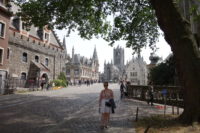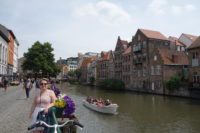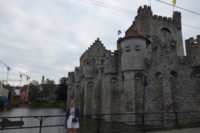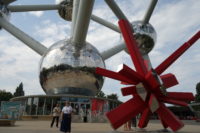 I have seen the future, and the future is 1958, which helps explain my lack of flying car. Since I was stuck on the ground, I allowed three hours for us to get our car to the Brussels train station to return it to Hertz, so that we would not get charged for an extra day. Since the car was due at 11:00, we left at 8:00. Normally, the trip from Dinant to Brussels is about an hour and twenty minutes, so I thought we were playing it pretty safe. Queue up the construction traffic jam, and my meandering attempt to get around it, and throw in circling the train station a few times trying to find where the car rental place was, and stop to ask a cab driver to help, which he very kindly does, pointing out the postage-stamp-sized sign of where to return the car, and find that the car return agent for Hertz is nowhere to be found for several minutes, and you return the car at 11:03. Happily, they did not charge us for the extra day. And so, we bid goodbye to the rental car, which is always a relief. I love the flexibility of a car, but am always anxious driving it in other countries where I can’t read the signs and I don’t know the conventions.
I have seen the future, and the future is 1958, which helps explain my lack of flying car. Since I was stuck on the ground, I allowed three hours for us to get our car to the Brussels train station to return it to Hertz, so that we would not get charged for an extra day. Since the car was due at 11:00, we left at 8:00. Normally, the trip from Dinant to Brussels is about an hour and twenty minutes, so I thought we were playing it pretty safe. Queue up the construction traffic jam, and my meandering attempt to get around it, and throw in circling the train station a few times trying to find where the car rental place was, and stop to ask a cab driver to help, which he very kindly does, pointing out the postage-stamp-sized sign of where to return the car, and find that the car return agent for Hertz is nowhere to be found for several minutes, and you return the car at 11:03. Happily, they did not charge us for the extra day. And so, we bid goodbye to the rental car, which is always a relief. I love the flexibility of a car, but am always anxious driving it in other countries where I can’t read the signs and I don’t know the conventions.
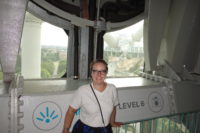 Since we were relying on the kindness of strangers to find the car rental station, we were blessed to have another kind man stop on the street when he saw us struggling with our map. He saw where we were trying to get to and told us where the metro was and which stop to get off at. He then wished us well and went on his way. What a great guy.
Since we were relying on the kindness of strangers to find the car rental station, we were blessed to have another kind man stop on the street when he saw us struggling with our map. He saw where we were trying to get to and told us where the metro was and which stop to get off at. He then wished us well and went on his way. What a great guy.
So, we checked into our four-star swanky hotel. I had some credit on the travel site Orbitz, so I used it to get us into a 390-euro-a-night hotel. Sweet. So, of course, they did not have my booking. It turned out my name was spelled incorrectly, and it was fine. I’d expected they were running a credit check on us and seeing that we didn’t really belong in such a hotel. It is a nice room, but it is funny how at the end of the day, it is just a bed and a bathroom, although the room does have a weak air conditioner. I’m used to American freeze-you-out air conditioning, and this one has been running for about ten hours now and has just kept the room at the same temperature (about 79 degrees).
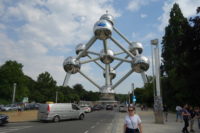 Since I had slept little last night because of Belgian national exuberance over World Cup play, and because I was feeling a little sick, I took an hour-long nap, which also helped us get into the later afternoon, which is when things could start to cool down. We headed to the northwest part of the city on the Metro, to go see the rather amazing Atomium.
Since I had slept little last night because of Belgian national exuberance over World Cup play, and because I was feeling a little sick, I took an hour-long nap, which also helped us get into the later afternoon, which is when things could start to cool down. We headed to the northwest part of the city on the Metro, to go see the rather amazing Atomium.
The Atomium is a sixty-year-old structure left over from Brussels’s 1958 World’s Fair. It is a giant atomic model mirroring the structure of an iron crystal. It was the central showpiece of the fair, and it is still pretty cool. It is 330 feet tall, and not only can you take an elevator to the top to the observation level, but you can also climb around inside five of the atoms as well. Most of the atoms tell the story of the 1958 World’s Fair. Some fun facts – forty million people came thought the fair; more than forty nations participated; and eight out of every ten Belgians went through the exhibition. It’s a pretty great exhibit.
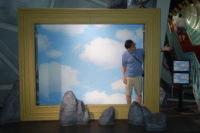 Two levels were showing some of the work of Magritte, a Belgian artist best know for a painting of a man wearing a bowler hat, but with an apple hiding his face. It was really interesting, and the exhibit brought out how Magritte was fascinated with the hidden – hidden faces, hidden scenery, and so on. Just knowing that little bit of information really helped me understand his work on display, and I really enjoyed it. Mer and I were even able to pose for Magritte-esque photos.
Two levels were showing some of the work of Magritte, a Belgian artist best know for a painting of a man wearing a bowler hat, but with an apple hiding his face. It was really interesting, and the exhibit brought out how Magritte was fascinated with the hidden – hidden faces, hidden scenery, and so on. Just knowing that little bit of information really helped me understand his work on display, and I really enjoyed it. Mer and I were even able to pose for Magritte-esque photos.
Most of the atoms were connected by escalators, and you could generally look out a porthole to see the connecting structures and the spheres. One of the escalators was wildly lit with pulsating colored lights, and even the normal staircases felt like you were moving around a space station. There was even one sphere set up with sphere-shaped beds to accommodate school sleepovers.
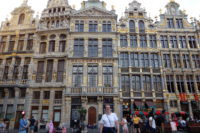 After a brief stop back at the hotel, we went to the area around the main old square, where we found a crepe restaurant and had supper. Afterwards, we took advantage of the evening air to do a book-guided walk around the square area, looking at the main hall and its tower, the gilded decorations of the old trade guilds, the first glass-roofed shopping arcade built in Europe, a recently cleaned church that I would have sworn looked as if it had been built in the last hundred years, and the main shopping streets all around – all pedestrian-only zones. There were people everywhere, and in the main square the town was setting up seating and lights for a concert series over the next few days. It was a lively scene. And yes, we did see a very small statue of a small boy peeing in a fountain.
After a brief stop back at the hotel, we went to the area around the main old square, where we found a crepe restaurant and had supper. Afterwards, we took advantage of the evening air to do a book-guided walk around the square area, looking at the main hall and its tower, the gilded decorations of the old trade guilds, the first glass-roofed shopping arcade built in Europe, a recently cleaned church that I would have sworn looked as if it had been built in the last hundred years, and the main shopping streets all around – all pedestrian-only zones. There were people everywhere, and in the main square the town was setting up seating and lights for a concert series over the next few days. It was a lively scene. And yes, we did see a very small statue of a small boy peeing in a fountain.
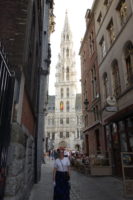 That took us back home, where we watched the end of the England-Columbia World Cup game – it was on in all the bars, so we decided to check it out. England won on penalty kicks.
That took us back home, where we watched the end of the England-Columbia World Cup game – it was on in all the bars, so we decided to check it out. England won on penalty kicks.
So, if I saw a little bit of the 1958 future, it was worth the trip out to the site. Our immediate future should hold some more good touring of Brussels tomorrow.
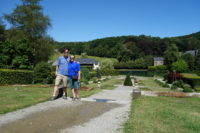
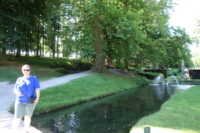
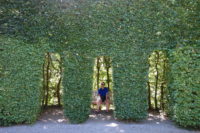
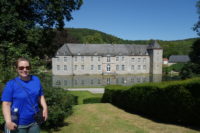
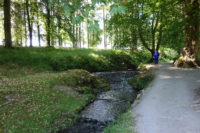
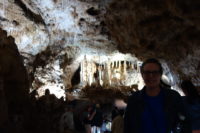
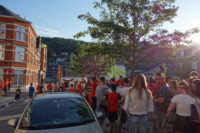
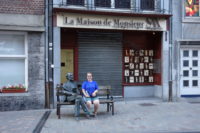
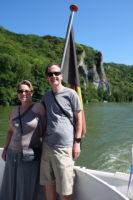
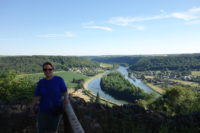
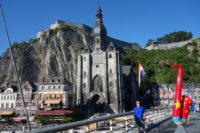
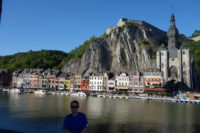
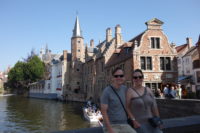
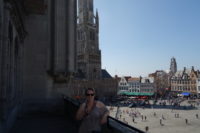
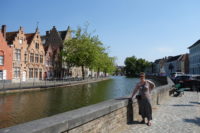
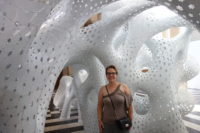
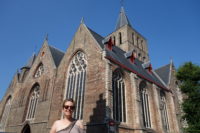
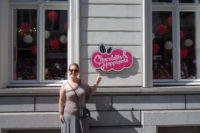
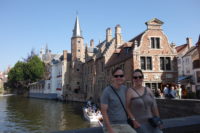
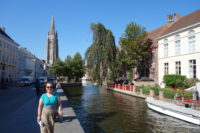
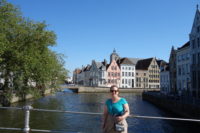
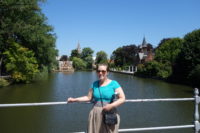
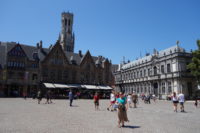
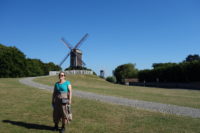
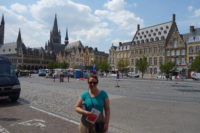
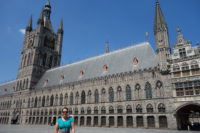
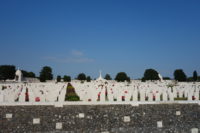
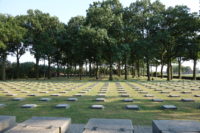
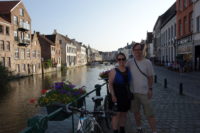
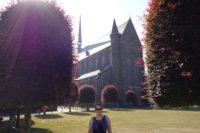
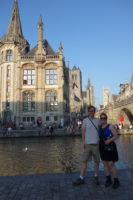
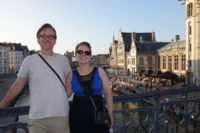
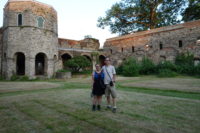
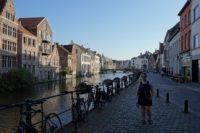
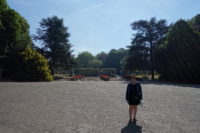
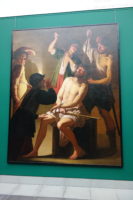
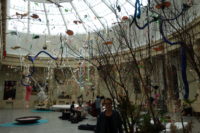
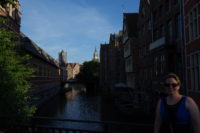
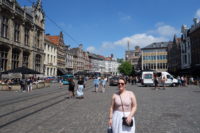
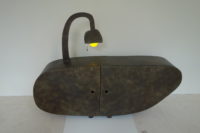
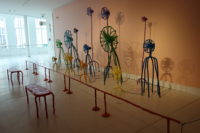
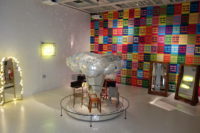
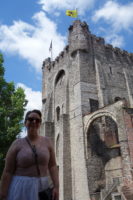
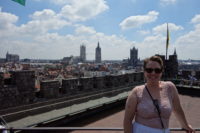
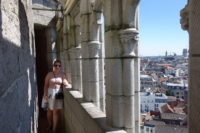
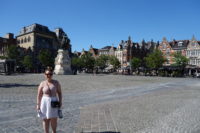
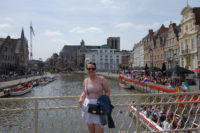
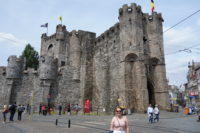 We took a tram from the train station to the historic center of Ghent, and then found our hotel, which is a converted monastery; the room that Meredith booked for us is really large and really nice. I told Mer there must be some mistake, since I usually am the one splurging for nice digs. We actually didn’t see the room until later in the afternoon – since it was 12:30, we were too early to check in, so we dropped our bags and went back into town for lunch.
We took a tram from the train station to the historic center of Ghent, and then found our hotel, which is a converted monastery; the room that Meredith booked for us is really large and really nice. I told Mer there must be some mistake, since I usually am the one splurging for nice digs. We actually didn’t see the room until later in the afternoon – since it was 12:30, we were too early to check in, so we dropped our bags and went back into town for lunch.